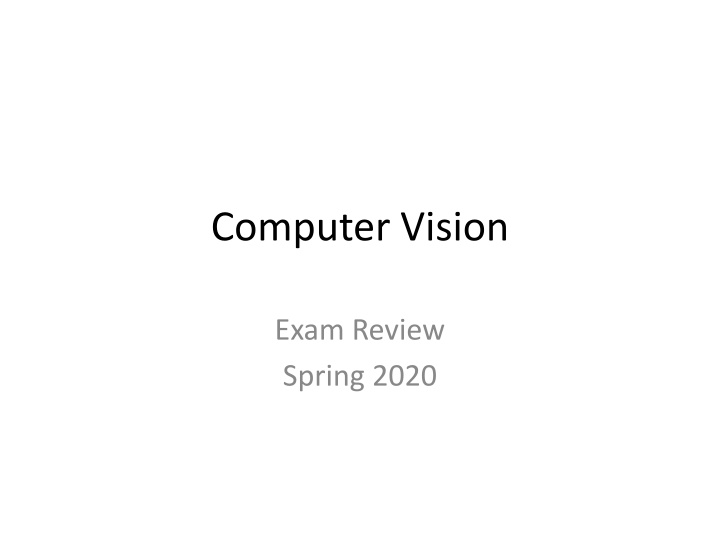
Visualizing Computer Vision Exam Review in Spring 2020
Discover the comprehensive review of Computer Vision Exam for Spring 2020, covering topics such as Human Vision Basics, Image Formation, 3D Vision, and more. Dive into Human Vision fundamentals and delve deeper into Computer Vision principles. Explore Human Vision chapters covering visual brain, depth perception, color perception, and various aspects of computer vision like image formation, enhancement, feature extraction, and stereo vision.
Download Presentation

Please find below an Image/Link to download the presentation.
The content on the website is provided AS IS for your information and personal use only. It may not be sold, licensed, or shared on other websites without obtaining consent from the author. If you encounter any issues during the download, it is possible that the publisher has removed the file from their server.
You are allowed to download the files provided on this website for personal or commercial use, subject to the condition that they are used lawfully. All files are the property of their respective owners.
The content on the website is provided AS IS for your information and personal use only. It may not be sold, licensed, or shared on other websites without obtaining consent from the author.
E N D
Presentation Transcript
Computer Vision Exam Review Spring 2020
Computer Vision Exam Review Spring 2020
Types of Questions (40% to Final) Multiple Choices on Human Vision 10 question, 3x10 points = 30 points Multiple Choices on Computer Vision 10 question, 3x10 points = 30 points Short Answers on both Human and Computer Vision 5 questions, 40 points total Proof, description, analysis
Course Outline Computer (& Human) Vision (14 meets) Part 0. Human Vision Basics (Total 2) 1. Human eyes and computer vision(1) 2. Visual brain, depth and color (1) Part 1. Computer Vision Basics (Total 3) 3. Image Formation and Processing (1) (hw 1, matlab) 4. Image Enhancement (1) ( hw 2) 5. Feature Extraction (1) Part 2. 3D Vision (Total 6) 6. Camera Models (1) 7. Camera Calibration (1)(hw 3) 8. Stereo Vision (2) (hw 4) 9. Visual Motion (2) (project assignments) Part 3. Exam and Projects (Total 3) 9. Midterm exam (1) 10. Project and Exam discussions (0.5) 11. Student Project presentations (1.5)
Human Vision Vision & Human Eyes (Ch. 1 and Ch. 2) Vision: An Overview Human and Animal Eyes The Pinhole Camera Human Eye: an Window to Brain
Human Vision Visual Brain(Ch. 3 and Ch. 4) Neurons, Receptive Fields & Human Brain From Retina to Visual Cortex Primary Visual Cortex (V1) Secondary Visual Cortex (V2)
Human Vision Depth(Ch. 5) Depth: The Rouge Dimension Motion: What Is It Good For? Stereopsis: Stereo Vision Shape from X Motion, Stereo, Shading, Texture
Human Vision Color (Ch. 7) Color & Light Information: Bit by Bit Retina Cells as Information Channels Color Systems and Conversions
Computer Vision Image Formation Image Formation Basic Steps Geometry Pinhole camera model & Thin lens model Perspective projection & Fundamental equation Radiometry Photometry Color, human vision, & digital imaging Digitalization Sampling, quantization & tessellations More on Digital Images Neighbors, connectedness & distances
Computer Vision Feature Extraction Image Enhancement Brightness mapping Contrast stretching/enhancement Histogram modification Noise Reduction ... Mathematical Techniques Convolution Gaussian Filtering Edge and Line Detection and Extraction Region Segmentation Contour Extraction Corner Detection
Computer Vision Camera Models Geometric Projection of a Camera Pinhole camera model Perspective projection Weak-Perspective Projection Camera Parameters Intrinsic Parameters: define mapping from 3D to 2D Extrinsic parameters: define viewpoint and viewing direction Basic Vector and Matrix Operations, Rotation Camera Models Revisited Linear Version of the Projection Transformation Equation Perspective Camera Model Weak-Perspective Camera Model Affine Camera Model Camera Model for Planes Summary
Computer Vision Camera Calibration Calibration: Find the intrinsic and extrinsic parameters Problem and assumptions Direct parameter estimation approach Projection matrix approach Direct Parameter Estimation Approach Basic equations (from Lecture 5) Homogeneous System Estimating the Image center using vanishing points SVD (Singular Value Decomposition) Focal length, Aspect ratio, and extrinsic parameters Discussion: Why not do all the parameters together? Projection Matrix Approach ( after-class reading) Estimating the projection matrix M Computing the camera parameters from M Discussion Comparison and Summary Any difference?
Computer Vision Stereo Vision Problem Infer 3D structure of a scene from two or more images taken from different viewpoints Two primary Sub-problems Correspondence problem (stereo match) -> disparity map Similar instead of Same Occlusion problem: some parts of the scene are visible only in one eye Reconstruction problem -> 3D What we need to know about the cameras parameters Often a stereo calibration problem Lectures on Stereo Vision Stereo Geometry Epipolar Geometry (*) Correspondence Problem (*) Two classes of approaches 3D Reconstruction Problems Three approaches
Computer Vision Visual Motion Problems and Applications The importance of visual motion Problem Statement The Motion Field of Rigid Motion Basics Notations and Equations Three Important Special Cases: Translation, Rotation and Moving Plane Motion Parallax Optical Flow Optical flow equation and the aperture problem Estimating optical flow 3D motion & structure from optical flow Feature-based Approach Two-frame algorithm Multi-frame algorithm Structure from motion Factorization method Advanced Topics Spatio-Temporal Image and Epipolar Plane Image Video Mosaicing and Panorama Generation Motion-based Segmentation and Layered Representation
Types of Questions (40% to Final) Multiple Choices on Human Vision 10 question, 3x10 points = 30 points Multiple Choices on Computer Vision 10 question, 3x10 points = 30 points Short Answers on both Human and Computer Vision 5 questions, 40 points total Proof, description, analysis
Computer Vision Exam Review Spring 2020
